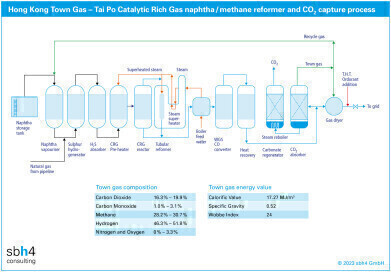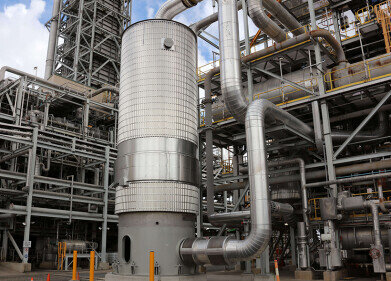Air Clean Up
Decarbonising the Hong Kong Town Gas Grid
Mar 06 2023
Author credit: Stephen B. Harrison, sbh4 consulting
Hong Kong has been using town gas for heating, cooking and industrial applications since 1864. At that time, coal gasification was the source of town gas. In 1967, the feedstock was changed to heavy fuel oil and in 1973 naphtha became the main feedstock.
Hong Kong’s modern Tai Po town gas plant commenced operation in 1986, using four Catalytic Rich Gas (CRG) trains. It was upgraded with an additional four CRG trains in 1992 to triple the town gas production capacity. The site received an additional 15% capacity upgrade in 2006 at which time pipeline natural gas was added to the feed mix. Today, the plant can generate more than 12 million cubic metres per day of town gas.
Natural gas now forms around 60% of the feed to the CRG process. The switch from pure naphtha-fed operation to the mix of naphtha and natural gas resulted in 20% less CO2 emissions from the process. SOx and NOx emissions reductions of 30% and 50% were also achieved.
A naphtha import terminal close to the Tai Po CRG plant unloads cargos to three storage tanks at the town gas production facility. The gas supply to the Tai Po Towngas plant is regasified LNG which is transported by a submarine pipeline from the Guandong Dapeng LNG terminal. The submarine pipeline runs for 34km to Tai Po in twin pipes, each of 450mm diameter at a maximum working pressure of 90 bar.
Each train of the Tai Po Towngas facility has a CRG reactor (pre-reformer), a tubular steam methane reformer and a CO converter (water gas shift reactor) at its heart. Upstream of these reactors is a desulphurisation unit to purify the feedstock and protect the reformer catalyst. Naphtha typically represents 40% of the feed to the process and may contain up to 100pm of sulphur. The natural gas feed is also desulphurised.
Leaving the reactors, the town gas is rich in hydrogen and CO2 but contains less than 3% carbon monoxide. However, at this point in the process the CO2 concentration is higher than would be desirable when the town gas is burned to produce a flame for heating or cooking. The next stage in the process is therefore CO2 removal using a hot potassium carbonate solution as a solvent.
The CO2 capture equipment is a twin tower process. In the first absorber tower, much of the moisture and CO2 is removed from the town gas stream as it is captured in the potassium carbonate solution. In the second tower, known as the CO2 stripper or carbonate regenerator, the CO2-rich potassium carbonate solution is boiled to release water vapour and CO2.
At present, the CO2 loaded gas stream from the stripper tower is emitted to atmosphere. However, in the future, this flue gas stream could be dried and the remaining CO2 could be liquefied to be utilised or sequestered. This enhancement would significantly reduce the carbon intensity of Hong Kong’s energy system. The path to gas grid decarbonisation in Hong Kong is clear.
The final stage of syngas preparation is drying. The final town gas product, containing around 50% hydrogen, 30% methane and 18% CO2 and 2% CO at around 30 bar pressure is then distributed throughout Hong Kong in a pipeline network.
A network of 3,700 km underground pipes distributes town gas to more than 1 million domestic, commercial, and industrial end-user locations in Hong Kong. As with natural gas distribution, the Hong Kong town gas is stenched with an odorant called THT (TetraHydroThiophene). This is a sulphur compound with a very strong smell which allows minor leaks to be detected by the human nose to minimise the risk of gas explosion accidents.
When the natural gas pipeline from the LNG terminal at Guandong was built, consideration was given to converting Hong Kong to natural gas and shutting down the CRG town gas plant. However, the costs and disruption associated with such a transition were regarded as excessive.
The issues discussed when the change from town gas to natural gas was considered in Hong Kong are like those that several cities are debating today as they consider decarbonisation options such as converting natural gas pipelines to pure hydrogen, or admixing hydrogen into natural gas grids.
Events
IWA World Water Congress & Exhibition
Aug 11 2024 Toronto, Canada
Aug 25 2024 Stockholm, Sweden and online
Sep 03 2024 Mexico City, Mexico
Sep 03 2024 Mexico City, Mexico
Sep 03 2024 San Diego, CA, USA














